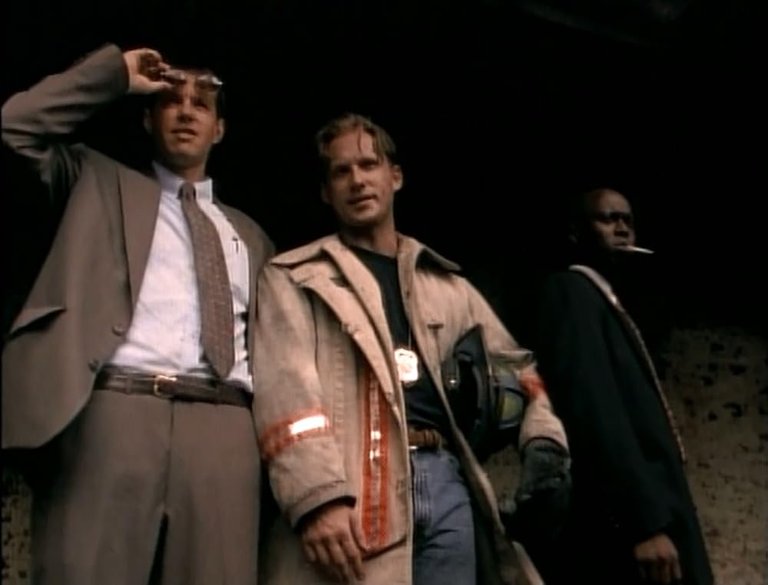
Fire, Part 1 (S04E01)
Airdate: 20 October 1995
Written by: Julie Martin
Directed by: Dan Scardino
Running Time: 48 minutes
The episodic nature of 20th-century US network television often necessitated abrupt cast changes between seasons, a structural quirk that Homicide: Life on the Street—despite its reputation for gritty realism—struggled to reconcile. The departure of actors Daniel Baldwin (Beau Felton) and Ned Beatty (Stan Bolander) between Seasons 3 and 4 exemplifies this tension. Baldwin’s exit, linked to real-life substance abuse issues, and Beatty’s dissatisfaction with scripts, forced the show to address their absences in a manner more akin to soap opera contrivance than procedural authenticity. Rather than allowing these characters to fade into the background organically, Fire, Part 1 opens with a clumsy narrative device: a suspension lasting “22 weeks” for drunken misconduct at a police convention. This timeframe conveniently aligns with Season 4’s 22-episode arc, signalling to audiences that Felton and Bolander—fan favourites from earlier seasons—would not return. While pragmatic, this explanation undermines the show’s commitment to realism, opting instead for a tidy, network-friendly resolution to off-screen drama.
The episode’s cold open juxtaposes the fallout from Felton and Bolander’s absence with the inciting incident of the plot. Detectives Munch and Howard discuss the duo’s suspension while observing a distant fire—a visual metaphor for the narrative chaos left in their wake. The 22-week suspension not only justifies their absence but also foreshadows the season’s serialised structure, a rarity for Homicide, which traditionally favoured standalone cases. This meta-commentary on cast turnover is clever but risks alienating viewers invested in the show’s earlier ensemble dynamics. The fire itself, a sprawling warehouse blaze, introduces the central homicide: a charred body discovered amid the ruins, forcing Pembleton and Bayliss to collaborate with arson investigator Mike Kellerman (played by Reed Diamond).
The investigation into the warehouse fire becomes a battleground for competing methodologies. Kellerman, representing the Arson Squad, clashes with Pembleton’s cerebral, intuition-driven approach. Their conflict is exacerbated by Captain Barnfather’s demands for a higher clearance rate—a pressure cooker scenario that strains Giardello’s leadership. Initial suspicions fall on Matthew Roland, a slum lord with a history of insurance fraud, but Kellerman’s theory unravels when Roland’s political connections shield him from scrutiny. The introduction of Lisa DeNardi (played by Tara Henson), who identifies the victim as her boyfriend Mark Landry, shifts the focus to a potential crime of passion. Yet, the absence of clear motives—Landry had no enemies—leaves the detectives adrift, culminating in a second fire and another body in the closing moments.
Screenwriter Julie Martin deftly uses Kellerman’s introduction to explore institutional friction. His reliance on paid informants and pragmatic shortcuts contrasts sharply with Pembleton’s principled rigour. This dynamic mirrors broader tensions within the squad, where Barnfather’s bureaucratic meddling threatens Giardello’s autonomy. Martin’s script succeeds in framing Kellerman as both an antagonist and a potential ally, though his arc risks overshadowing the show’s established ensemble. The jurisdictional disputes—arson vs. homicide—add layers of procedural complexity, but the episode’s pacing suffers under the weight of exposition, particularly in scenes explaining Kellerman’s backstory.
Reed Diamond’s casting as Kellerman injects youthful charisma into the series, a deliberate counterpoint to the grizzled veterans. The episode leans into his “matinee idol” appeal, notably in a semi-comical scene where Veronica Velez (played by Margaret Trigg) feigns witness testimony to seduce him. While this moment risks veering into exploitative fan service—a rare misstep for Homicide—it ultimately reinforces Kellerman’s professionalism; he rebuffs her advances, prioritising duty over distraction. Yet, the scene’s tonal inconsistency (slapstick humour in a grim procedural) highlights the show’s struggle to balance character development with its noirish aesthetic. Diamond’s performance, however, salvages these moments, portraying Kellerman as a flawed but compelling addition to the roster.
Amid the central investigation, Fire, Part 1 weaves in subplots that underscore the squad’s fractured dynamics. Howard’s decision to take the sergeant’s exam—a promotion that would distance her from fieldwork—reflects her ambition and the unit’s institutional decay. Lewis, still reeling from Crosetti’s suicide, remains adrift without a permanent partner, a thread that foreshadows his eventual pairing with Kellerman. Meanwhile, Pembleton’s revelation about his wife’s pregnancy—a rare moment of vulnerability—hints at existential fears about parenthood in a violent world. These arcs, though underdeveloped in the episode, anchor the narrative in the show’s trademark emotional realism.
Directed by Tim Hunter, Fire, Part 1 is structurally sound, with taut pacing and atmospheric cinematography that heightens the urgency of the arson investigation. The performances—particularly Andre Braugher’s Pembleton and Yaphet Kotto’s Giardello—remain riveting, balancing gravitas with subtle humanity. However, the episode’s reliance on contrivances—the 22-week suspension, Kellerman’s abrupt introduction, and the cliffhanger ending—betrays a concessions to network expectations. For a series that once subverted procedural conventions, these choices feel disappointingly formulaic.
Fire, Part 1 serves as a functional, if uneven, transition into Homicide’s fourth season. Its handling of cast departures—while narratively tidy—clashes with the show’s realist ethos, and Kellerman’s introduction, though promising, risks diluting the ensemble’s chemistry. Yet, the episode’s strengths—sharp dialogue, moral complexity, and Braugher’s towering performance—ensure it remains compelling television. For all its conventional leanings, Fire, Part I retains enough of Homicide’s DNA to satisfy purists, even as it hints at the creative compromises ahead.
RATING: 6/10 (++)
Blog in Croatian https://draxblog.com
Blog in English https://draxreview.wordpress.com/
InLeo blog https://inleo.io/@drax.leo
Hiveonboard: https://hiveonboard.com?ref=drax
Rising Star game: https://www.risingstargame.com?referrer=drax
1Inch: https://1inch.exchange/#/r/0x83823d8CCB74F828148258BB4457642124b1328e
BTC donations: 1EWxiMiP6iiG9rger3NuUSd6HByaxQWafG
ETH donations: 0xB305F144323b99e6f8b1d66f5D7DE78B498C32A7
BCH donations: qpvxw0jax79lhmvlgcldkzpqanf03r9cjv8y6gtmk9
Posted Using INLEO